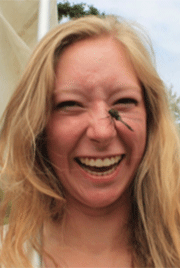My "toad"-ally neat experience in the Crowsnest Pass
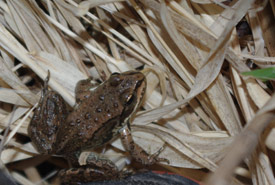
Columbia spotted frog at "Calling all Amphibians" CV event, Frayn Property, AB (Photo by NCC)
Did you know there are only 10 amphibian species native to Alberta? I, too, was surprised to learn this. Although I have known basic facts about frogs and toads since I was in elementary school, like how they have a tadpole phase and prefer wet habitats, it wasn’t until I began creating materials for our Conservation Volunteers event in the Crowsnest Pass, Calling All Amphibians, that I began learning more about specific amphibian species.
On May 15, I had the opportunity to take that knowledge our of the office and get some hands-on experience surveying for these amphibians at our event.
Alberta's 10 amphibian species |
||
| Species name | Call sounds like... | Video link |
| Northern leopard frog | Rubbing a balloon | http://ow.ly/Ncd6q |
| Columbia spotted frog | A helicopter | http://ow.ly/NcdTN |
| Wood frog | Somewhat like a duck | http://ow.ly/NccOJ |
| Boreal chorus frog | Fingernails running down a comb | http://ow.ly/NccvP |
| Boreal toad | Soft peeps | http://ow.ly/Ncg0E |
| Canadian toad | High pitched trill | http://ow.ly/Nzw9r |
| Great plains toad | Chirping | http://ow.ly/Nzw3N |
| Plains spadefoot | Duck-like noise | http://ow.ly/Nzwfs |
| Long-toed salamander | Salamanders do not call | http://ow.ly/Nzww0 |
| Tiger salamander | Salamanders do not call | http://ow.ly/NzwCB |
To find out more about any of these species, go to ESRD's amphibian information page.
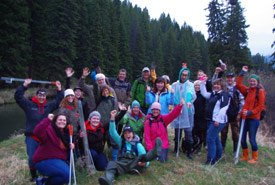
Group shot at "Calling all Amphibians" CV event, Frayn Property, AB (Photo by NCC)
Just after supper time on the day of the event, volunteers and NCC staff met in the town of Blairmore, right beside NCC’s Frayn property. This piece of land is dominated by riparian and wetland ecosystems, making it an ideal spot to look for frogs, toads and salamanders.
Unlike most volunteer events, which are held during the day, this volunteer opportunity went from 7 p.m. to 11:30 p.m. at night. We started the evening with a lesson about the seven different amphibian species native to the Crowsnest Pass area, led by Yvonne Bazin, M.Sc., professional biologist and amphibian expert. Then we proceeded to pre-selected sites that had been flagged as potential amphibian habitat.
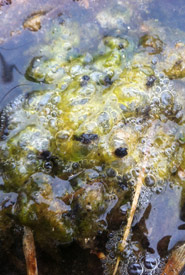
Frog eggs, Calling all Amphibians CV event, Frayn Property, AB (Photo by NCC)
We spent the rest of the daylight hours visually surveying these locations in an attempt to spot northern leopard frogs, Columbia spotted frogs, boreal chorus frogs, wood frogs, long-toed salamanders, tiger salamanders or boreal toads.
Thanks to the keen eyes of volunteers, we managed to find a total of five individuals: two wood frogs, two boreal chorus frogs and a Columbia spotted frog! We also came across two clusters of frog eggs, which belonged to either Columbia spotted frogs or northern leopard frogs. The eggs of these species look so similar that NCC staff will have to return once the newborns have become adults to determine which species the eggs are from.
At sunset, we retreated from the property for a coffee break and amphibian call lesson. As 15 volunteers, five staf, and an amphibian expert sat with doughnuts and coffee in hand to listen to the recordings of five frog and toad species’ calls, I can only imagine what the other patrons at Tim Hortons were thinking.
It was worth it the funny looks though, as it prepared the volunteers to head out into the night and listen with a more trained ear. That evening, we were listening for the boreal chorus frog, wood frog, Columbia spotted frog, northern leopard frog and boreal toad.
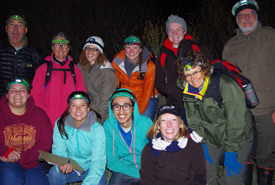
Night group shot at "Calling all Amphibians" CV event, Frayn Property, AB (Photo by NCC)
At 10:45 p.m., the volunteer crew braved the cold and darkness to return to the property. We stood, silently on the boardwalk, waiting for the show. Waiting in the silent chill of a cold Albertan night, we wondered if we would hear a frog or toad at all.
Seven minutes slowly ticked by with the volunteers in eager wait of the amphibian calls. Good thing it was dark: no telling what highway travellers would have guessed a dozen people were doing standing in silence and staring into a wetland!
We tried our best, but in the end we did not hear any amphibians that evening. One inevitable reality of nature and surveys of the wild is that there are times when conditions do not suit the animals you are searching for. Although the optimal breeding time for amphibians in Alberta is mid- to late-May, the optimal breeding temperature is above five degrees Celsius.
Our awesome volunteers did not seem to mind at all though; they were now equipped with the knowledge to search for frogs, toads, and salamanders all over the province!
All the observations made that night have been recorded and submitted to the Alberta Conservation Association’s Amphibian monitoring program and recorded in NCC’s Land Information System so we can compare these results with those of future amphibian surveys on the property.
Thanks to volunteers, we not only have a better idea of what species NCC has on our property, but also have more data on amphibian populations and distributions that can be used for future research and conservation initiatives. This is vitally important: amphibians are very sensitive to water quality and changes in land use practices, making them indicators of the health of an ecosystem. Their increased sensitivity makes them vulnerable to changes in the climate and pollution levels, so keeping an eye on populations is an important way to ensure these species are present in Alberta forever.
Thank you to our volunteers!
If you want to get involved with initiatives like this one, be sure to check our Conservation Volunteers page or in Alberta, email Alberta@conservationvolunteers.ca. For some fun facts about each of Alberta’s ten amphibian species, check out #AmphsofAB on Twitter.

